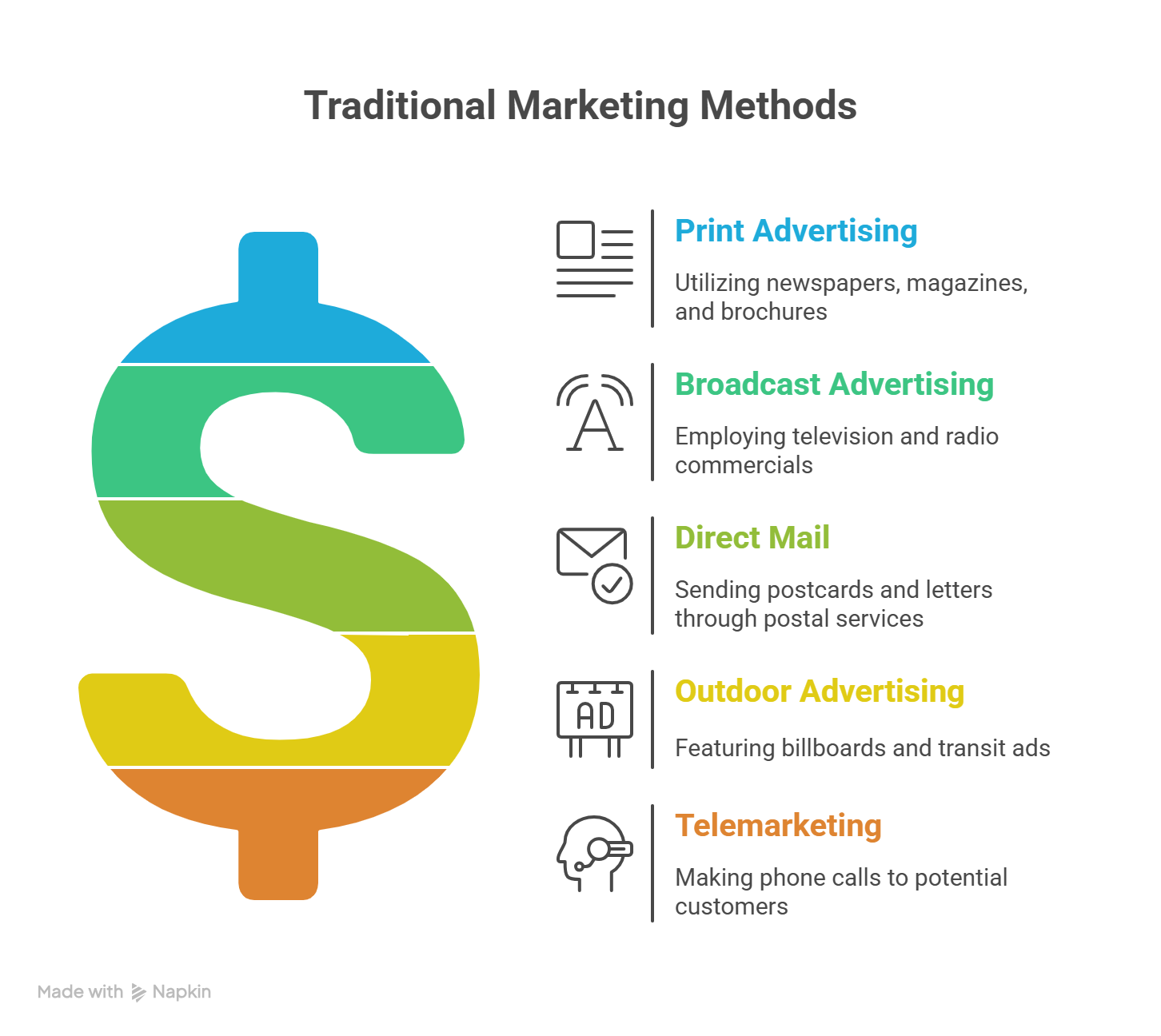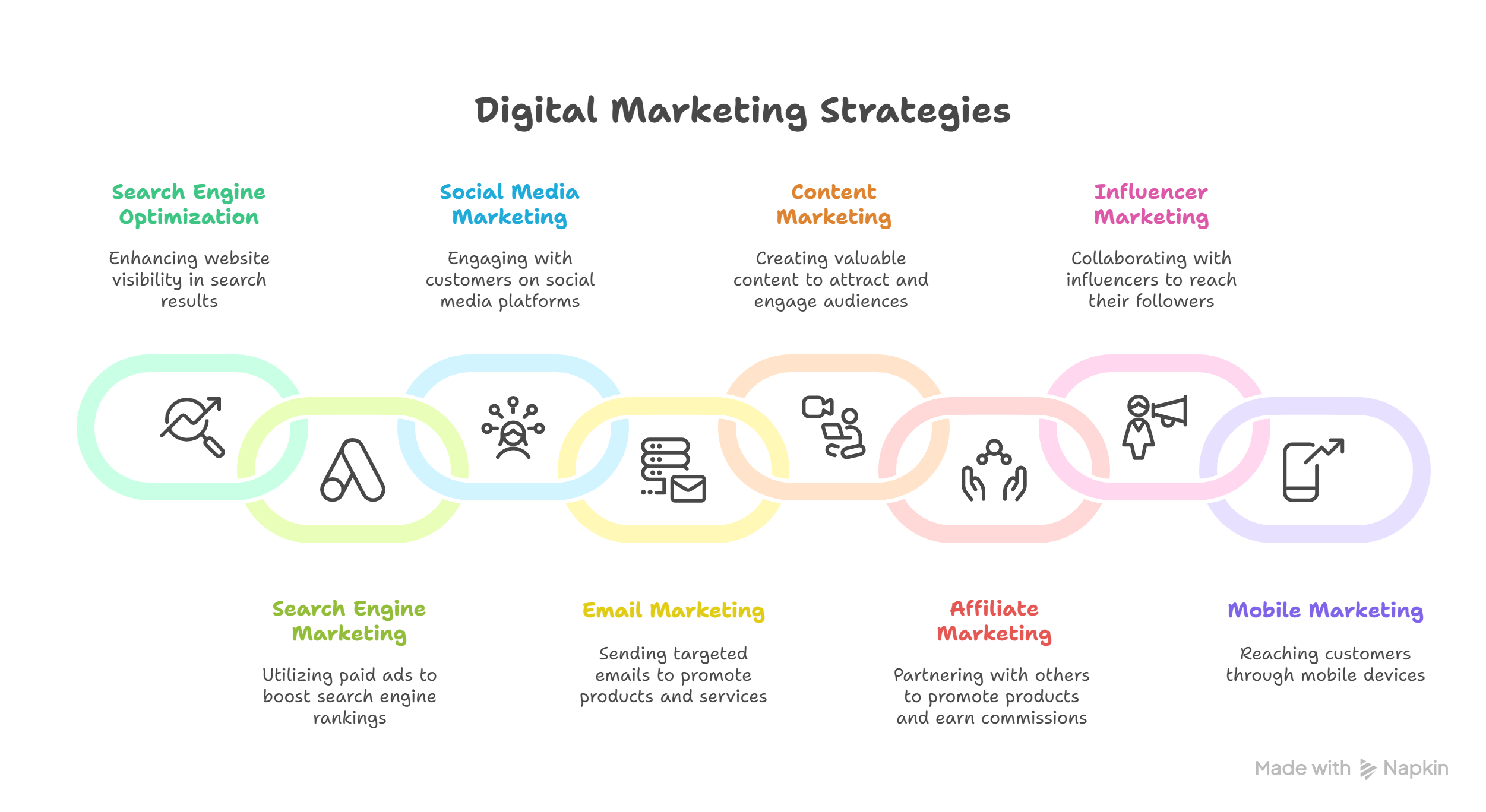Introduction
Marketing has evolved significantly over the years. The traditional methods that once dominated the landscape are now sharing the stage with a dynamic and rapidly expanding digital realm. Understanding the nuances of both traditional and digital marketing is crucial for businesses aiming to connect with their target audience effectively.
Traditional Marketing
Traditional marketing encompasses all marketing efforts that are not online. These methods have been around for decades and have proven their effectiveness in building brand awareness and reaching a broad audience.
Examples of Traditional Marketing
- Print Advertising: Newspapers, magazines, brochures, flyers.
- Broadcast Advertising: Television and radio commercials.
- Direct Mail: Postcards, catalogs, letters sent through postal services.
- Outdoor Advertising: Billboards, posters, transit advertising (buses, trains).
- Telemarketing: Making phone calls to potential customers.
Advantages of Traditional Marketing
- Reaching a Broad Audience: Traditional marketing can reach a large and diverse audience, especially through television and radio.
- Tangible and Memorable: Print materials and physical advertisements can leave a lasting impression. People can hold, read, and revisit them.
- Credibility: Some consumers perceive traditional media as more credible and trustworthy than online sources.
- Local Reach: Effective for targeting local communities through newspapers, local radio, and direct mail.
Disadvantages of Traditional Marketing
- High Cost: Traditional marketing methods, such as television commercials and print ads, can be expensive.
- Difficult to Measure ROI: Tracking the return on investment (ROI) for traditional marketing campaigns can be challenging. It’s hard to directly attribute sales to a specific ad.
- Limited Targeting: Traditional marketing often involves a “spray and pray” approach, reaching a broad audience, many of whom may not be interested in the product or service.
- Lack of Interactivity: Traditional marketing is typically one-way communication, with limited opportunities for customer interaction or feedback.
- Environmental Impact: Print advertising contributes to paper waste and can have a negative environmental impact.
Digital Marketing
Digital marketing encompasses all marketing efforts that utilize the internet and digital technologies to reach potential customers. It’s a dynamic and data-driven approach that allows for precise targeting and measurable results.
Examples of Digital Marketing
- Search Engine Optimization (SEO): Optimizing website content to rank higher in search engine results.
- Search Engine Marketing (SEM): Using paid advertising on search engines like Google (e.g., Google Ads).
- Social Media Marketing (SMM): Engaging with customers and promoting products/services on social media platforms (e.g., Facebook, Instagram, Twitter, LinkedIn).
- Email Marketing: Sending targeted emails to subscribers to promote products, services, or provide updates.
- Content Marketing: Creating and distributing valuable, relevant, and consistent content to attract and engage a target audience (e.g., blog posts, videos, infographics).
- Affiliate Marketing: Partnering with other businesses or individuals to promote products/services and earn a commission on sales.
- Influencer Marketing: Collaborating with influencers to promote products/services
Advantages of Digital Marketing
- Precise Targeting: Digital marketing allows for highly targeted advertising based on demographics, interests, behaviors, and location.
- Measurable Results: Digital marketing campaigns can be tracked and measured in real-time, providing valuable data on ROI and campaign performance.
- Cost-Effective: Digital marketing can be more cost-effective than traditional marketing, especially for small businesses with limited budgets.
- Interactive and Engaging: Digital marketing allows for two-way communication and engagement with customers through social media, comments, and online forums.
- Global Reach: Digital marketing can reach a global audience, allowing businesses to expand their reach beyond geographical boundaries.
- Personalization: Digital marketing enables personalized messaging and offers based on customer data and preferences.
- Flexibility and Adaptability: Digital marketing campaigns can be easily adjusted and optimized based on performance data.
Disadvantages of Digital Marketing
- Requires Technical Expertise: Digital marketing requires technical skills and knowledge of various platforms and tools.
- Constantly Evolving: The digital marketing landscape is constantly evolving, requiring marketers to stay up-to-date with the latest trends and technologies.
- Competition: The online marketplace is highly competitive, making it challenging to stand out from the crowd.
- Ad Blocking: Many users use ad blockers, which can prevent online ads from being displayed.
- Privacy Concerns: Data privacy is a growing concern, and businesses need to be transparent about how they collect and use customer data.
- Security Risks: Digital marketing activities are vulnerable to security risks, such as hacking and data breaches.
Traditional Marketing vs. Digital Marketing: A Comparison Table
| Feature | Traditional Marketing | Digital Marketing |
| —————- | ————————————— | —————————————– |
| Reach | Broad, often geographically limited | Global, highly targeted |
| Cost | Generally higher | Generally lower |
| Measurability | Difficult to measure ROI | Easy to track and measure ROI |
| Targeting | Limited targeting capabilities | Precise targeting based on demographics, interests, etc. |
| Interactivity | Limited interaction | Highly interactive and engaging |
| Personalization| Limited personalization | High level of personalization |
Choosing the Right Approach
The choice between traditional and digital marketing depends on several factors, including:
- Target Audience: Where does your target audience spend their time? Are they more likely to be reached through traditional media or online channels?
- Budget: How much can you afford to spend on marketing? Digital marketing can be more cost-effective for small businesses.
- Business Goals: What are your marketing objectives? Are you trying to build brand awareness, generate leads, or drive sales?
- Industry: Some industries are better suited to traditional marketing, while others thrive on digital marketing.
- Product/Service: The nature of your product or service can influence the best marketing approach.
Conclusion
Both traditional and digital marketing have their strengths and weaknesses. The most effective marketing strategy often involves a combination of both approaches, leveraging the strengths of each to achieve optimal results. By understanding the nuances of each approach and carefully considering their target audience, budget, and business goals, businesses can create a comprehensive marketing plan that drives growth and success. The key is to adapt and evolve with the changing marketing landscape, embracing new technologies and strategies while staying true to core marketing principles.




